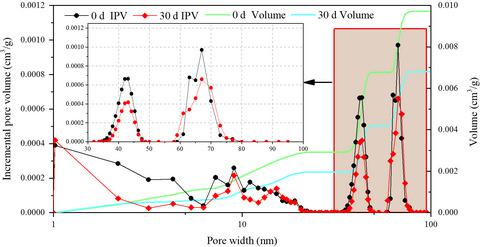当前位置:
X-MOL 学术
›
Energy Sci. Eng.
›
论文详情
Our official English website, www.x-mol.net, welcomes your
feedback! (Note: you will need to create a separate account there.)
Influence of water soaking on swelling and microcharacteristics of coal
Energy Science & Engineering ( IF 3.5 ) Pub Date : 2019-10-20 , DOI: 10.1002/ese3.508 Guangcai Wen 1, 2, 3 , Shuo Yang 1, 2, 3 , Yanbao Liu 2, 3 , Wenbin Wu 2, 3 , Dongling Sun 2, 3 , Kai Wang 4
Energy Science & Engineering ( IF 3.5 ) Pub Date : 2019-10-20 , DOI: 10.1002/ese3.508 Guangcai Wen 1, 2, 3 , Shuo Yang 1, 2, 3 , Yanbao Liu 2, 3 , Wenbin Wu 2, 3 , Dongling Sun 2, 3 , Kai Wang 4
Affiliation

|
Improving the coal seam permeability is an important measure for increasing the coal bed methane (CBM) production and preventing gas disasters. Hydraulic technologies are effective ways of improving coal seam permeability. However, hydraulic technologies can also cause water to enter the coal seam, allowing the coal seam to soak for a long time. In this study, to obtain the influence of water soaking on the microscopic characteristics of coal, X‐ray diffraction (XRD), scanning electron microscopy (SEM), free swelling ratio tests, and low‐temperature nitrogen adsorption tests (LT‐NATs) were conducted. The mineral compositions of raw coal samples, the variation regularities of micromorphologies, and pore characteristics of the samples with different soaking times were obtained. The results showed that the coal samples contained about 8.5% clay minerals, of which 71% were illite/smectite mixed‐layer. Expansions of different sizes in the areas where the surface of the soaked coal samples contained clay minerals were observed, and the swelling was also observed macroscopically. The swelling not only led to an increase in the coal sample volume but also led to a decrease in pore volume. This change was magnified with the increase in soaking time (within 30 days). The cumulative pore volume of the samples soaked for 30 days was 0.00681 cm3/g. This was a reduction of 29.9% compared to the unsoaked samples. Moreover, the pore volumes show a logarithmic dependence on soaking time. This study provides evidence that the coal containing clay minerals will swell obviously when soaked in water, and the hydration swelling of clay minerals has a great influence on the swelling of coal. This swelling would lead to a decrease in the pore volume and the efficiency of CBM transport, thus affecting the effect of hydraulic measures.
中文翻译:

浸水对煤溶胀和微观特性的影响
提高煤层渗透性是增加煤层气产量和预防瓦斯灾害的重要措施。水力技术是提高煤层渗透性的有效途径。但是,水力技术也会导致水进入煤层,使煤层长时间浸泡。在这项研究中,为了获得浸水对煤的微观特性的影响,X射线衍射(XRD),扫描电子显微镜(SEM),自由溶胀比测试和低温氮吸附测试(LT-NAT)进行了。获得了不同浸泡时间的原煤样品的矿物成分,微观形貌的变化规律和孔隙特征。结果表明,煤样中含有约8种。粘土矿物占5%,其中伊利石/蒙脱石混合层占71%。在浸透的煤样品的表面包含粘土矿物的区域中观察到了不同大小的膨胀,并且在肉眼上也观察到了溶胀。溶胀不仅导致煤样品体积增加,而且导致孔隙体积减小。随着浸泡时间(30天以内)的增加,这种变化被放大。浸泡30天的样品的累积孔体积为0.00681 cm 随着浸泡时间(30天以内)的增加,这种变化被放大。浸泡30天的样品的累积孔体积为0.00681 cm 随着浸泡时间(30天以内)的增加,这种变化被放大。浸泡30天的样品的累积孔体积为0.00681 cm3 /克。与未浸泡的样品相比,减少了29.9%。此外,孔体积显示出对时间的对数依赖性。这项研究提供了证据,证明含粘土矿物的煤在水中浸泡后会明显膨胀,并且粘土矿物的水合溶胀对煤的溶胀有很大的影响。这种膨胀将导致孔体积的减小和CBM输送效率的降低,从而影响水力措施的效果。
更新日期:2019-10-20
中文翻译:

浸水对煤溶胀和微观特性的影响
提高煤层渗透性是增加煤层气产量和预防瓦斯灾害的重要措施。水力技术是提高煤层渗透性的有效途径。但是,水力技术也会导致水进入煤层,使煤层长时间浸泡。在这项研究中,为了获得浸水对煤的微观特性的影响,X射线衍射(XRD),扫描电子显微镜(SEM),自由溶胀比测试和低温氮吸附测试(LT-NAT)进行了。获得了不同浸泡时间的原煤样品的矿物成分,微观形貌的变化规律和孔隙特征。结果表明,煤样中含有约8种。粘土矿物占5%,其中伊利石/蒙脱石混合层占71%。在浸透的煤样品的表面包含粘土矿物的区域中观察到了不同大小的膨胀,并且在肉眼上也观察到了溶胀。溶胀不仅导致煤样品体积增加,而且导致孔隙体积减小。随着浸泡时间(30天以内)的增加,这种变化被放大。浸泡30天的样品的累积孔体积为0.00681 cm 随着浸泡时间(30天以内)的增加,这种变化被放大。浸泡30天的样品的累积孔体积为0.00681 cm 随着浸泡时间(30天以内)的增加,这种变化被放大。浸泡30天的样品的累积孔体积为0.00681 cm3 /克。与未浸泡的样品相比,减少了29.9%。此外,孔体积显示出对时间的对数依赖性。这项研究提供了证据,证明含粘土矿物的煤在水中浸泡后会明显膨胀,并且粘土矿物的水合溶胀对煤的溶胀有很大的影响。这种膨胀将导致孔体积的减小和CBM输送效率的降低,从而影响水力措施的效果。











































 京公网安备 11010802027423号
京公网安备 11010802027423号